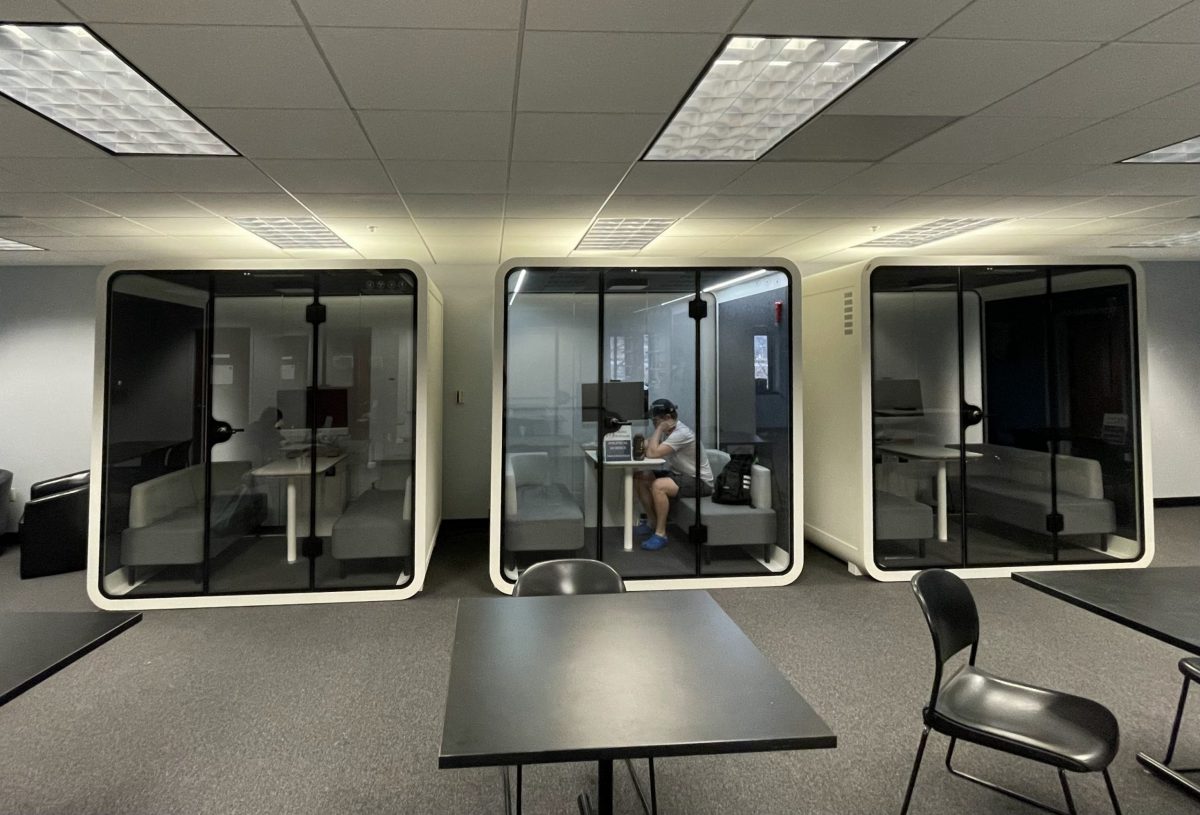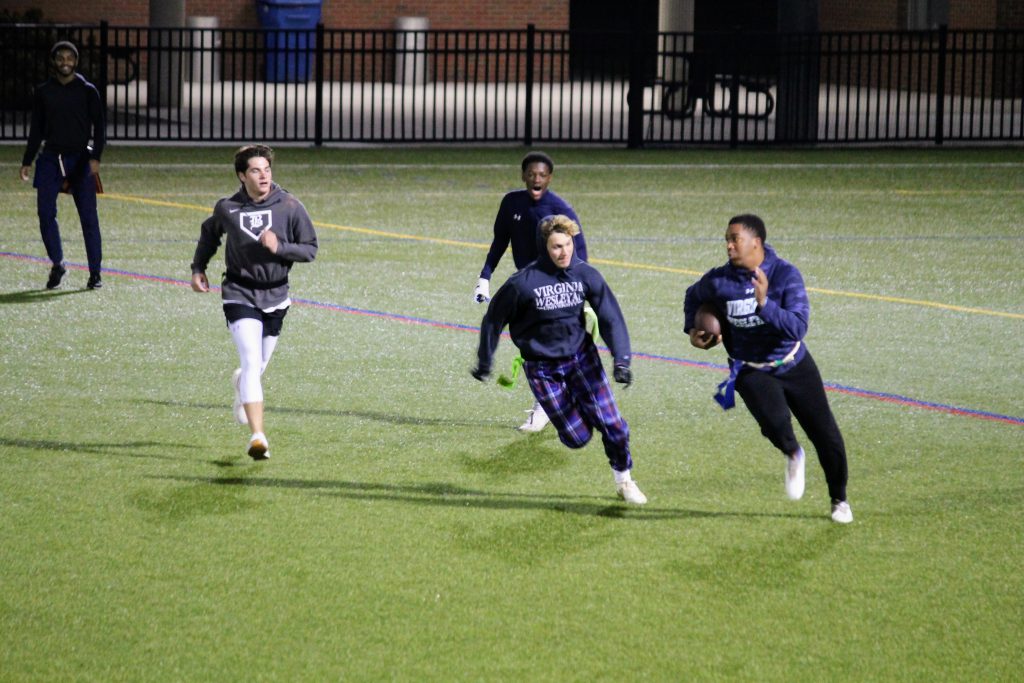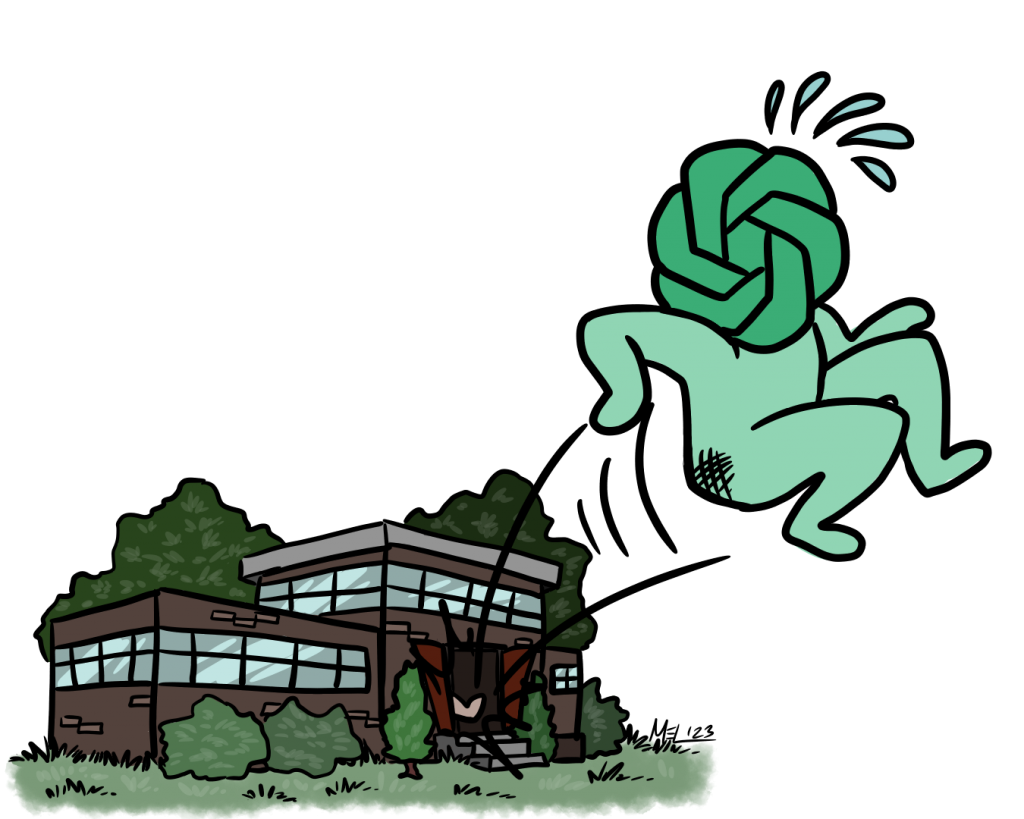Featured Image: Student studies in pod in the Learning Center shortly after construction finished. Carley Tantlinger | Marlin Chronicle
New study pods in Clarke Hall exemplify university efforts to invest in technology development.
In the constant scramble for universities to possess the most advanced technology in education, Virginia Wesleyan University strives to stay ahead of the curve with new gadgets rolling in to finish off recent Clarke Hall renovations. Among them are the human-sized transparent boxes known as “Study Pods.”
Associate Vice President for Campus Life and Operational Management Jason Seward said being on par with the technological innovations of other universities matters to VWU.
Seward said these renovations were executed with the collaborative input of faculty, students, workforce development and the university’s partners at NetTek, a local tech company. The renovations all aligned with “being cutting edge in what the latest, greatest technology is.”
“You go to any kind of new space that’s young and vibrant and entrepreneurial, they have these types of pods where folks can come out of a meeting or come out of a class and want to write a thought down quickly or maybe send an email but don’t want to sit at a loud table,” Seward said.
A sign posted on the front of these study pods prior to their completion read: “Need a quiet space to study? Reduce the noise around you? Duck in to take a call? The Study Pod is for you!”
The sign listed the features including noise reduction, a worktable with “comfortable seating,” lighting, a fan and USB charging. It also noted that the pod circulates through a complete air change every two minutes.
The group study pods arrived later, having to be carried piece-by-piece into the elevator and up to the second-floor Learning Center. A hub for resources such as peer-tutoring and test accommodations, the Learning Center qualifies as a fitting place for the study pods.
The initial appearance of the two single-person pods in the lobby of Clarke Hall mystified the Marlin community. Reactions grew stronger as they considered logistics.
Students realized that every person who enters the building will pass by anyone who uses the pod, creating the effect of being watched.
Sophomore Kaitlyn Duswalt said she finds the public placement of the single pods a bit awkward and would feel uncomfortable using one.
At first, junior Brice Johnson said he found them weird because of their “space age” feel, but warmed up to them after trying it. “When I stepped in there, it felt really calm and just like a quiet study space,” Johnson said.
“The ones up in the tutoring area have two benches, a table and a computer,” Johnson said, adding that he prefers those over the single pods.
Nonetheless, Johnson said he thinks that people, including himself, will use them. He also thinks the library would be a good place to add more of them.
Kayla Bissette, senior and student worker at the Learning Center, is also more optimistic about group study pods, but unconvinced by the single pods.
“I’ll feel like a goldfish,” Bissette said about using the single person pods. “I look at that booth even when there’s nobody in it, so when there is somebody in it, or I know if I were to be that person in it, everybody’s going to be looking.” Because of this, Bissette said that trying to study in that pod would only increase stress.
As for the pods in the Learning Center, Bissette said that noise is not often a barrier, but she could benefit from the pods with simultaneous sessions occurring.
“I think that the tutoring pods, when used and shared properly, those will be helpful.” In comparison to the previous normal table layout, Bissette said, “I can see where it would allow for a more focused session.”
Brynna Lister, sophomore and Learning Center tutor, said they find the study pods unnecessary. Lister said the room is generally quiet already.
Similar to Johnson, Lister thinks the library would be a more appropriate location for the pods given its higher space availability and likelihood to have more distractions.
However, much of the new technology seems to be going into Clarke. As for what else is confirmed to be coming, Seward said for classrooms in Clarke, “We’ve got state-of-the-art touchscreen projectors, so there’s no more whiteboards.”
Additionally, Seward said there will be an investment lab designed for student use where, through Brown Financial, students will be able to trade environmentally-friendly stock.
In the Finance Lab upstairs in Clarke, students will be able to work at “two trading portfolio stations that are in real-time connected to the stock market and track, trade, buy, sell.”
In President Miller’s Feb. 20 Nota Bene, Miller said, “The Finance and Investment Lab gives all learners the opportunity for real-world training and experience to develop much-needed life skills for financial decision-making in their personal or professional lives.”
Seward also highlighted technology that has been present in Clarke, such as the cyber security map that tracks attacks live on an international scale.
Bissette said that universities seeking the latest and greatest can stem from various intentions, “What is the motivation behind updating the technology? Are we doing it because it’s something that students are saying that they need, or that professors are saying would be helpful, or is it an advertising thing?”
Bissette acknowledged that as a student worker, she doesn’t know the ins-and-outs of the university’s resource allocation and therefore cannot fully flesh out an opinion on technological expenses.
However, Bissette said she thinks the university should first ask, “Are the basic technological needs met?” She suggested a chromebook renting system for students in need as an example.
Lister shared a related opinion. “Schools should pursue education alongside technology, but I feel like the budget could have been used instead to update some of the chalkboards to whiteboards, or something of a more pressing matter like maintaining elevators for disabled students,” Lister said.
On the contrary, some students praise these technological additions. As a tutor for the Learning Center, junior Gavin Prouty has first-hand experience using the group study pods.
Prouty said, “The school should put a priority on technological advances because it helps add to students’ experience. The new study pods are a great way to show the school’s intention to improve and bring students to Clarke.”
By Lily Reslink
lbreslink@vwu.edu


